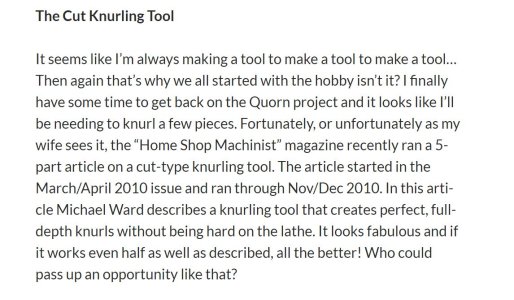Unless the perpetrators didn't realize what they were doing, I doubt the magazine can accomplish anything. It simply costs too much to hire the requisite lawyers to force a change. Sad really.
Believe it or not, I am so curious about this that I watched a dozen YouTube videos. I learned nothing. All it accomplished was to further entrench my dislike of YouTube.
There were quite a few examples of single cutter horizontal cut knurling as well.
One of them showed a single light pass is the middle of some stock as well as a shot of the horizontal alignment of the grooves in the cutting wheel to achieve that result.

All this watching and studying only accomplished one thing - a massive headache.
They show swarf chips, and you talk about chips, but all I see is a varient of pressure knurling. I simply cannot see any cutting action there at all.
One video even portended to describe the theory. That particular author has no clue what the word theory means. His only accomplishment was to bore me to death. If I never ever watch another of his videos it will be way too soon.
I still have that suspicious feeling that I am missing something simple but critical. Perhaps the teeth on the wheel are not the same as they are on a pressure wheel. Maybe they are like tiny little scoops that start to scoop out a cut above the centerline and then pull the swarf out below the centerline? Are these wheels different in some important way? If so, where do you get them?
If what I am asking has any relevance, could you post a close-up photo of a cutting wheel for me?
Last, but not least, how does such a cutter establish its timing? Are they somehow matched to the diameter in a way that establishes equally sized contiguous nubs? Or do they somehow space out their cuts to establish integer intervals?
The top roll acts kind of like a rotating tangential tool. The bottom roller is less clear, I think its action is a little different with the cutting face not the flat surface but the V's which notch a triangle out of the helical grooves created by the upper wheel.
Believe it or not, I am so curious about this that I watched a dozen YouTube videos. I learned nothing. All it accomplished was to further entrench my dislike of YouTube.
There were quite a few examples of single cutter horizontal cut knurling as well.
One of them showed a single light pass is the middle of some stock as well as a shot of the horizontal alignment of the grooves in the cutting wheel to achieve that result.
All this watching and studying only accomplished one thing - a massive headache.
They show swarf chips, and you talk about chips, but all I see is a varient of pressure knurling. I simply cannot see any cutting action there at all.
One video even portended to describe the theory. That particular author has no clue what the word theory means. His only accomplishment was to bore me to death. If I never ever watch another of his videos it will be way too soon.
I still have that suspicious feeling that I am missing something simple but critical. Perhaps the teeth on the wheel are not the same as they are on a pressure wheel. Maybe they are like tiny little scoops that start to scoop out a cut above the centerline and then pull the swarf out below the centerline? Are these wheels different in some important way? If so, where do you get them?
If what I am asking has any relevance, could you post a close-up photo of a cutting wheel for me?
Last, but not least, how does such a cutter establish its timing? Are they somehow matched to the diameter in a way that establishes equally sized contiguous nubs? Or do they somehow space out their cuts to establish integer intervals?

